Art and Culture
Come for the Whales. Stay for the Fur
In the seventh instalment of an ongoing Quillette series on the history of Canada, Greg Koabel describes how 16th-Century Basque whalers created a thriving industry in the waters off Newfoundland

What follows is the seventh instalment of The Nations of Canada, a serialized project adapted from transcripts of Greg Koabel’s ongoing podcast of the same name, which began airing in 2020.
The previous instalment of this series focused on the French failure to establish a permanent settlement on the St. Lawrence River in the 1540s. In the basic history lessons all Canadians get in school (or at least, the ones I got), this initial failure is followed by a fifty-year gap in the narrative, before the French try again. I’ve always wondered about that period: Why did the French abandon their colonial plans, and what caused them to pick them up again a generation or two later?
There are many such blank spots in my understanding of Canadian history, and this series is partly an attempt on my part to fill them in.
So, what exactly was going on during the second half of the 16th century? Had Europeans simply decided that Canada wasn’t worth the bother?
There are a few different ways of answering that question. The first has to do with internal French politics. A few years after Jacques Cartier returned from Canada in 1542, France entered a decades-long period of instability and civil war known as the Wars of Religion. Gone were the days when a King like Francis I had the resources required to sponsor a vanity project (as some saw it) like New France.
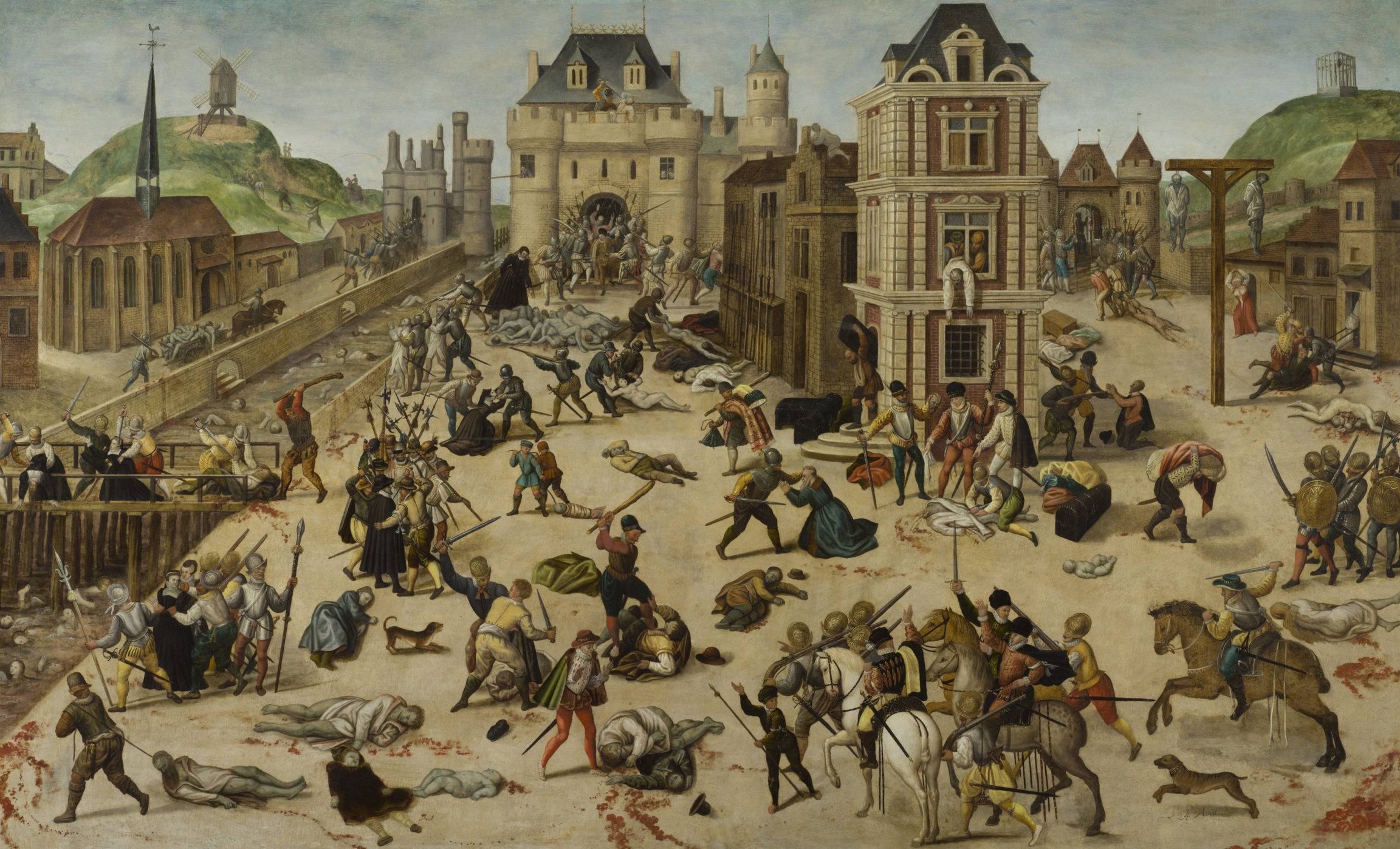
The second explanation for the lack of a European presence on the St. Lawrence during this period was the Spanish response to Cartier’s voyages. Part of France’s motivation to establish a presence in Canada was to counter Spanish colonial power. The Spanish had a good chuckle at the disaster that was New France, but the potential threat to their global power was all too real. And so, in the years that followed, Canada became a strategic priority for the Spanish. They mobilized their resources in the North Atlantic to block any future French attempt at colonization.
Before examining the situation in France, I will note that I don’t want to spend too much time on the civil wars that ravaged the country from the 1550s to the 1590s. But it is worth covering those details that will become relevant once the French return to Canada in the early 17th century.
The problems started about fifteen years after the failed attempt to colonize the St. Lawrence in the early 1540s. The old King, Francis I, had died a few years earlier. And his son, Henri II, took up the family tradition of battling the Hapsburgs in Italy. But by 1559, Henri and his father’s old nemesis, Emperor Charles V, were ready for a permanent peace. The treaty they signed—part of the Peace of Cateau-Cambrésis—represented a compromise between the two exhausted powers.
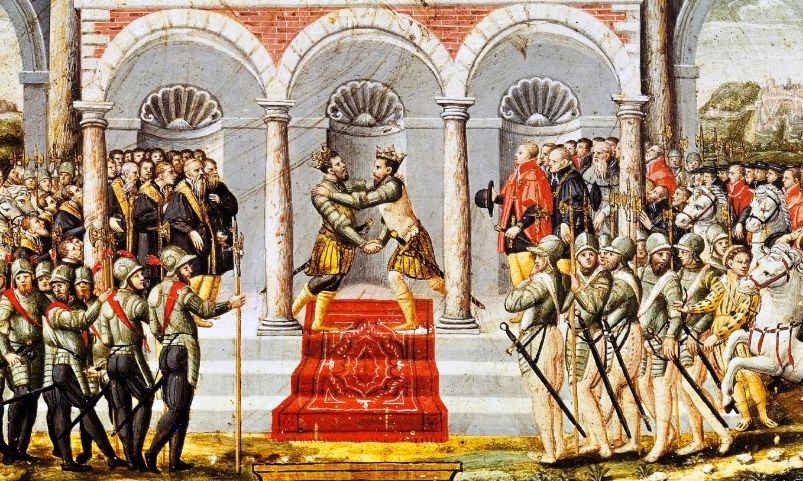
We don’t need to get into all the details of what lands were transferred to which monarch, but the major outcome of the peace was the division of the Hapsburg realms into two separate political units—with one side centered in Spain and the other in Austria. Charles stepped down as Holy Roman Emperor and passed the Spanish crown to his son, Philip II, and the Imperial title to his brother, Ferdinand I. The two Hapsburg lines would remain on friendly terms, and usually allied with one another, but the threat of universal Hapsburg domination of Europe subsided.
At this point, you’re probably thinking that this sounds great for France—so where’s the problem?
As it happens, things began going sideways during the treaty celebrations. In a joust marking the occasion, a shard split off from a lance, and drove through the brain of 40-year old King Henri.
The Crown then passed to Henri’s 15-year-old son, Francis II. However, the real power behind the throne was the House of Guise, an ambitious aristocratic family. The source of their power was Mary Queen of Scots, who had recently married the newly crowned King Francis.
As the only surviving (legitimate) child of James V, Mary had been the nominal ruler of Scotland since infancy (hence, “of Scots”). Her mother was Mary of Guise, who governed Scotland as regent while her daughter lived in France under the care of Queen Catherine de’ Medici. The House of Guise now used this family connection to seize control of the French state.
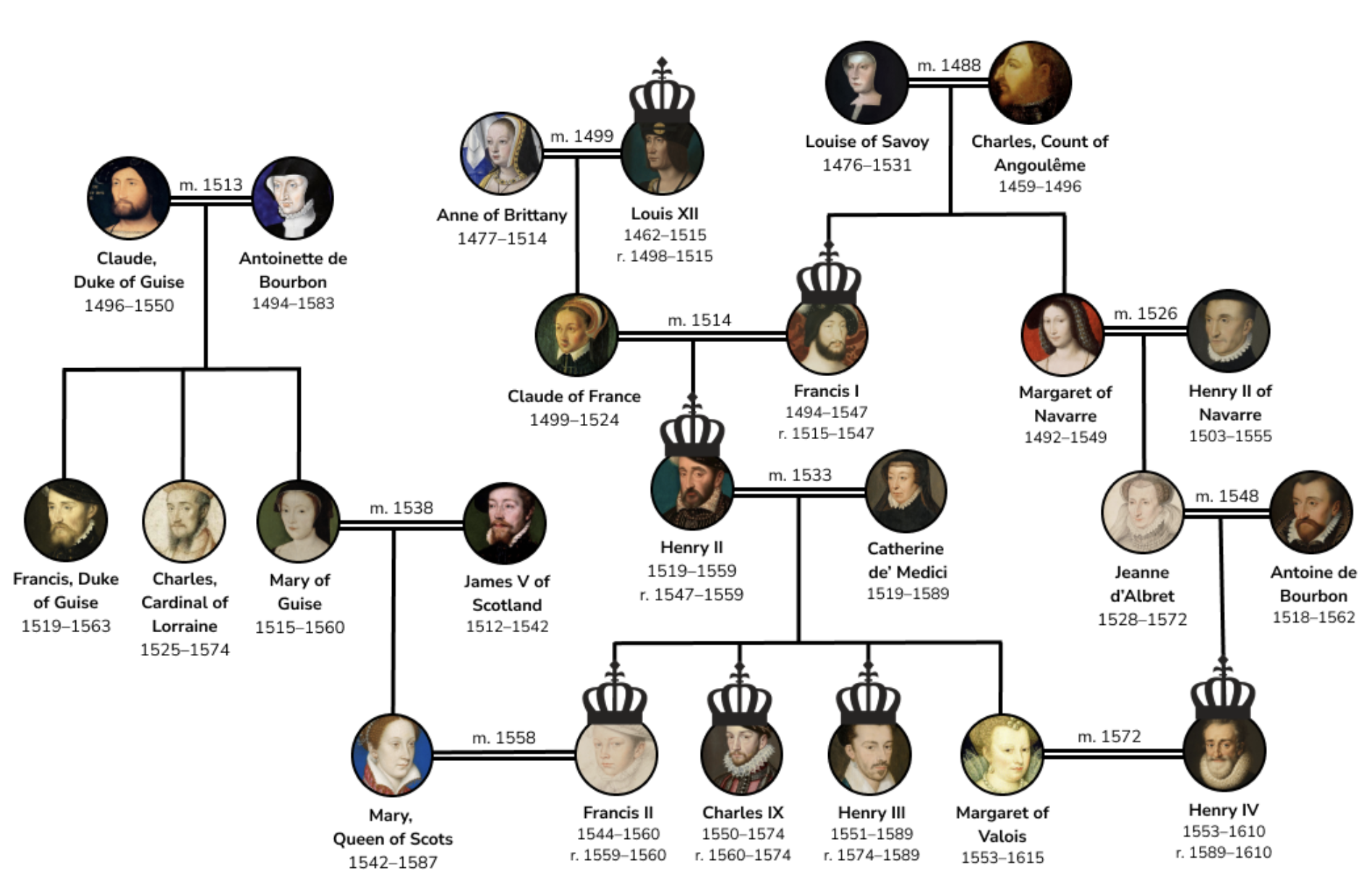
What followed was a confusing mixture of dynastic, regional, and religious conflict. The Catholic House of Guise took a hard line on the growing Protestant Huguenot movement within France. In part, this was because the House of Bourbon—rivals with a closer blood tie to the royal family—were sympathetic to the Protestant cause. (In 1589, the first Bourbon king, Henry IV, would take the throne. Once in power, he shed his Huguenot affiliation and converted to Catholicism as a means to calm France’s religious tensions.)
Under the guidance of the Guise clan, young King Francis embarked on a brutal campaign of repression against the Huguenots. As it turned out, the first prominent victim of this campaign was Jean-François Roberval—who’d been, as some readers might remember, the Protestant aristocrat named by Francis I to (haplessly and briefly) serve as Lieutenant-General of New France in 1541. But Francis died in late 1560, at 16 years of age, after only 17 months on the throne.
For the next thirty years, France was consumed by violence that pitted the great families of the realm against one another—a series of wars punctuated by short-lived truces. The most dramatic moment came on St. Bartholomew’s Day, 1572. What was supposed to be a wedding celebrating the union of the Catholic and Protestant factions instead turned into a massacre. Many of the leading Protestants, who’d traveled to Paris for the festivities, were butchered. It would take another twenty years of fighting before order was restored to France.
That highly abbreviated version of French history hopefully will provide readers with some idea as to why Canada was no longer a top priority for the Kings of France during this period.
One element worth dwelling on, from a Canadian perspective, is that these Wars of Religion were driven by dynastic and regional divisions as much as religious ones. In the 16th century, France was hardly the centralized state it is today. Rather, it was a patchwork of territories, each with its own distinct relationship to the French Crown. And the chaos of civil war allowed many of these informally united regions to re-negotiate their relationship to the central government.
In the context of Canada, the region to focus on lies on the western Atlantic coast, centred around the port town of La Rochelle.
The Huguenot movement often made its deepest inroads in trading centres, among the merchant class. Nowhere was this more true than in La Rochelle, which became the most firmly established Huguenot centre in the whole French kingdom.
Along with St. Malo in Brittany, and the ports on the Seine in Normandy, La Rochelle was one of the major French ports connected to the Newfoundland fishery. In fact, La Rochelle, and the surrounding coastal region owed its wealth and prominence almost entirely to cod. Unlike the Norman ports (which were linked to Paris by the Seine), or nearby Bordeaux, La Rochelle did not sit on a river that provided access to the interior of the country. For centuries, this had limited the usefulness of the port as a commercial centre. But that all changed with the explosion of cod fishing in the 15th and 16thcenturies.
La Rochelle’s ticket to success was the salt deposited all along the coast (especially in the salty marshes to be found on the Isle of Rhé, perched just off-shore from the city). Salt was a key ingredient in the preservation of cod. A nearly endless supply of it, along with direct access to the Atlantic, made La Rochelle the perfect locale for high-seas fishermen.
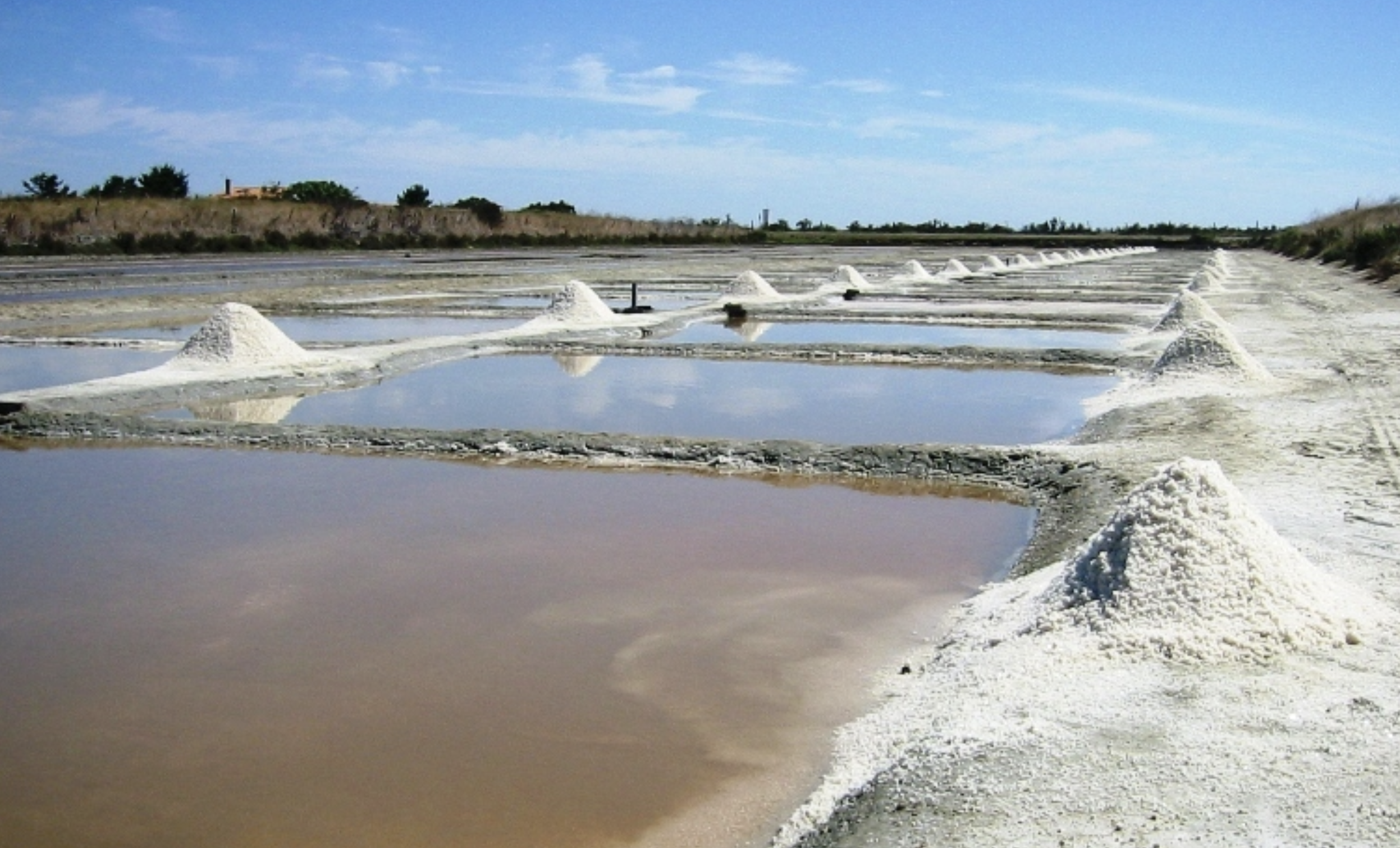
By the time of the French Wars of Religion, La Rochelle was a thriving commercial centre—the greatest Huguenot stronghold in the kingdom. And its dual status as a Protestant redoubt and trans-Atlantic powerhouse will make La Rochelle a key player in the future of our Canadian story.
The second explanation for the abandonment of the French colonizing project—which involves the Spanish—is a bit of a longer story. But it’s necessary to our narrative because the French Wars of Religion did not entirely snuff out French colonial ambitions. During the 1550s and 1560s, the French attempted to establish settlements in Florida and Brazil. None of these projects were successful, but they did demonstrate that French resources weren’t entirely directed toward internal conflicts.
Part of the story here also involves the Basques—an ethnic group straddling southern France and northern Spain, with its own language and culture. During this era, some Basques were aligned with the French, and others with the Spanish. But for the most part, they remained distinct and autonomous players in the contest for global riches.
By the time Cartier returned to France in disgrace after his third voyage, his ships full of false diamonds, European fishermen had spent about fifty years exploiting the Grand Banks cod fisheries off Newfoundland. They found this to be far more profitable than exploring rivers in search of some fabled passage to the Orient.
Even as Cartier was pushing up the St. Lawrence, English, Spanish, Portuguese, French, and Basque fishermen were engaged in a fierce competition. In fact, Cartier’s explorations were, in some sense, a product of this battle. As late-comers, the French were forced to search for alternate fishing grounds, as all the best spots on the Atlantic side of Newfoundland had already been claimed. The knowledge of the Gulf of St. Lawrence they developed while seeking other spots to fish cod likely sparked Cartier’s project.
In hopes of securing exclusive control over this valuable resource (or, at least, the best fishing grounds), some European governments sponsored year-round settlements on the Atlantic coast. The idea here was that this would allow their fishermen to get a head start in the spring, while also providing military support for the inevitable conflicts that would arise between crews.
Portugal was the first to pursue this avenue. In 1521, Henry, King of Portugal, granted a patent to João Álvares Fagundes to colonize Cape Breton, part of modern Nova Scotia. Fagundes established a permanent facility where Portuguese ships could land and preserve their catch. He was forced to abandon the project due to the hostility of rival fishermen. But the possibility of similar Portuguese or Spanish settlements being built in the future played a role in King Francis I sponsoring Cartier’s voyages.
As things turned out, the French King needn’t have worried. Even by the 1540s, when Cartier and Roberval were setting up shop on the St. Lawrence, the fishing season off Newfoundland was still a largely private affair. Ships from multiple European ports competed against one another with little regard for national or religious affiliations back home.
But while these were not state-backed fishing fleets, they were impressive in size. Cod exerted a powerful draw. One English intelligence report in the 1550s estimated that an average of 150 French ships made the trip every summer. About 100 came from Spain, 50 from Portugal, and another 50 from England. Basque ports on either side of the Franco-Spanish border sent another 50.
For a long time, historians have assumed these numbers were exaggerations. But archival evidence in France suggests that the Newfoundland fleets might actually have been larger. In 1559, almost 200 ships from Rouen, Bordeaux, and La Rochelle took out insurance for fishing voyages across the Atlantic. This total does not include captains who did not take out insurance, or ships from ports where the records have not been preserved (most notably, St. Malo). It’s entirely possible that in the middle of the 16th century, Newfoundland’s cod was attracting far more European shipping than the legendary riches of the Caribbean.
It’s important to note, however, that cod wasn’t the only thing in Newfoundland drawing the interest of Europeans. The same confluence of ocean currents that made the region so fertile in fish (with warm water from the Caribbean hitting cold water from the floating ice of Greenland) also attracted whales.
The European whaling fleets in Newfoundland did not quite match those coming in search of cod. But blubber was a valuable commodity, since whale oil, which could be produced by cooking blubber in ovens, had many uses back in Europe. Perhaps the most important use was in the textile industry, which was then one of the driving forces of Europe’s economy: Whale oil was a key ingredient in the cloth-making process, being applied to raw wool before it could be spun into yarn.
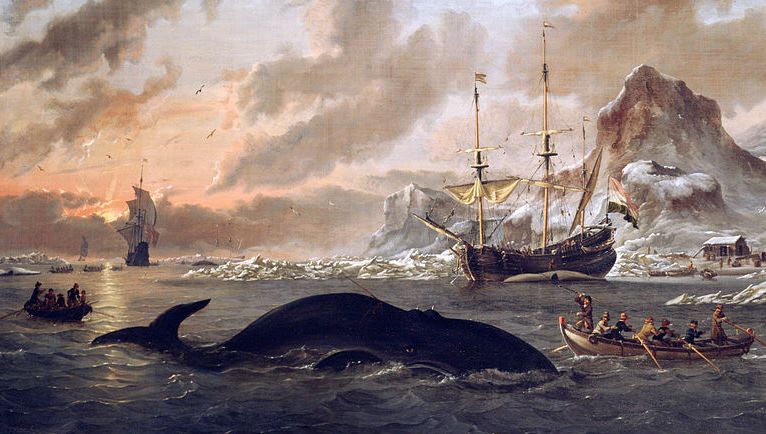
In addition to being a valuable commodity, whale oil was also one whose production required specialized skills. The contrast with cod is instructive. On Jacques Cartier’s first voyage into the St. Lawrence, his men had brought up huge quantities of cod simply by dropping weighted baskets into the sea. Hunting whales, by contrast, was dangerous work that required training and generations of accumulated experience.
And no Europeans had accumulated more experience hunting whales than the Basques. (I limit the scope here to Europeans quite deliberately: Once the Basques arrived in Canadian waters, they found that the Inuit had a thing or two to teach them about whaling.)
The homeland of the Basques straddles the Pyrenees mountains along the Atlantic coast. The northern Basques tended to be associated with the French Crown, while those on the south side of the mountains were tied to the Spanish Kings. But such allegiances were often of a mostly theoretical nature, especially when it came to whalers operating thousands of kilometers from Paris and Madrid. And the ambiguous political status of the Basques will be a common theme in the early years of the European presence in Canada.
The Basque coast, nestled in the corner of the Bay of Biscay, was frequently used by right whales as they made their seasonal migrations between the north and the south. At some point in the 11thcentury, the Basques turned these 60-ton sea mammals into a commercial commodity. Coincidentally, this was around the same time that Thule whale hunters were moving east acrosss the Arctic into the North Atlantic, where they became known to us as the Inuit.
The species of whale was important. In fact, there is a theory that the name “right whale” comes from the notion that they are the “right” or “correct” whale to hunt. Right whales are “baleen whales,” which distinguishes them from toothed whales such as dolphins, porpoises, or killer whales. Rather than teeth, these whales use a kind of filtration system in their mouths to extract nutrients from the sea. This system, called the “baleen,” consists of a series of bristles that are strong yet flexible. Hunters harvested this material and sold it as whalebone. Strictly speaking, it isn’t bone, per se. But its properties nevertheless made it quite useful for making such consumer items as baskets, buggy whips, and corset stays.
And even amongst the baleen family of whales, the right whales were especially “right.” They tended to be slow-moving and docile. And, most conveniently for whalers, they floated when dead.
Even so, acquiring whale blubber in sufficient quantities to make whale oil a viable export commodity required a lot of work. It took generations to develop harpoon technologies, and safe and efficient hunting tactics. The Basques also took advantage of their rugged terrain by employing lookouts on elevated headlands to alert whalers in port when the seasonal catch had arrived.
As the Basques honed their techniques, crews began to seek out high-quality whaling grounds further afield. After all, it seemed that it would be easier to catch the whales at their final destination, rather than in transit off the Basque coast. This took the Basques on an odyssey across the North Atlantic. During the 15th century, in fact, its possible the Basques were just as active in the undiscovered waters of the far Atlantic as English fishermen out of Bristol.
The specialized skills of the whalers transformed Basque society. Where the economy had previously been geared toward inland trade, especially toward central Spain, money now flooded into developing port facilities. The improved infrastructure turned the Basque ports into major centres of fishing as well.
On the French side of the mountains, Saint-Jean-de-Luz emerged as a major commercial centre. On the other side of the Pyrenees, San Sebastian became a European leader in ship building and naval outfitting. All the wealth coming in created a pool of capital that nurtured a financial sector as mature as those in many of Europe’s leading cities.
Processing whale blubber was a far more involved process than drying and salting cod. In order to do their work, whalers needed a base on land. Whales had to be dragged to shore so that their blubber could be cut away. The blubber then had to be cooked in specially designed ovens, so as to process the raw material into oil.
All this required more sophisticated land-based facilities than were required by the fishermen seeking to dry their cod catch. Which is good news for the historically curious. Among all the Europeans who visited Canada’s Atlantic coast in the 16th century, no one left more archaeological evidence than Basque whalers.
The earliest definitive evidence of whaling stations that we have dates to the 1510s. Very quickly, the whalers identified the Strait of Belle Isle as the prime hunting ground in the region. This was the long strait between the northern tip of Newfoundland and Labrador that Cartier (and most other Europeans) used to enter the Gulf of St. Lawrence. The narrow, 125-km-long passageway created dangerous tidal currents, but it also produced a thriving ecosystem that was attractive to whales.
Although both sides of the Strait of Belle Isle were dotted with Basque whaling stations, the largest was at Red Bay, a sheltered natural harbour near the northern end of the strait, on the Labrador coast. Every season, around fifteen ships and 1,000 men used the site.
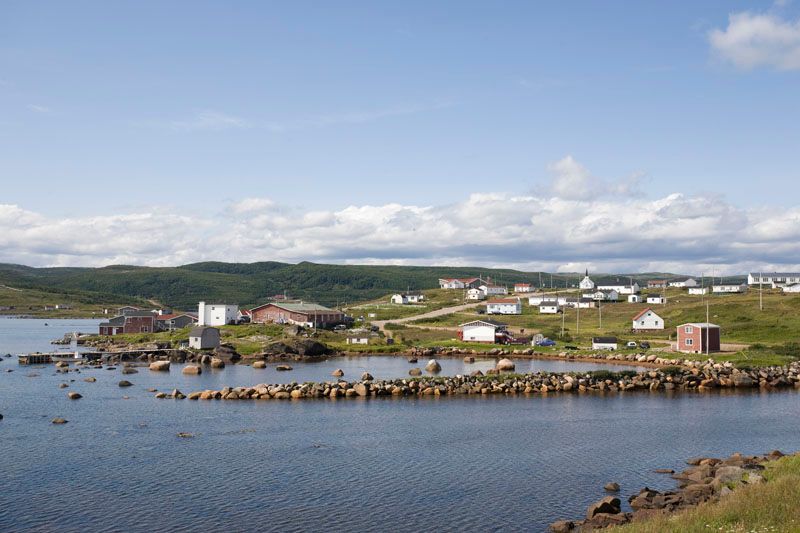
In addition to several ovens, the Red Bay site included multiple workshops. On-site coopers were needed to build the barrels necessary to transport whale oil. The ships brought staves and barrel tops from Europe every spring, which needed to be assembled and properly sealed for the season’s haul to make it home.
Speed and efficiency were key. The whalers had to leave by late summer, before the always-dangerous strait was made even more perilous by floating ice. Crews had to strike a balance between the oncoming winter and the desire for a full cargo hold. In addition to finding ovens, archaeologists have also uncovered the remains of men who pushed their luck too far and ended up stranded in Labrador over the winter.
At this point in our whaling adventure, you may have forgotten that the main organizing theme here was supposed to be the French retreat from the St. Lawrence after Cartier’s failed attempts at colonization. What do Basque whalers in the Strait of Belle Isle have to do with France’s (failed, to this point) settlement of the St. Lawrence?
The answer lies in the Spanish reaction to the French colonial experiments of the 1540s. While the gold and silver mines of the New World served as a bottomless purse from which Spain’s monarchs could fund their wars in Europe, they knew that their global network was vulnerable. Moving vast quantities of precious metal tends to draw the interest of unsavoury characters. Rivals such as France and England didn’t have to mimic the Spanish by building a vast, expensive network of military installations. A few well placed bases, capable of launching raids on Spanish shipping, would be enough to capture all the gold and silver being moved around in treasure fleets. On this basis, they reasoned that a French colony in Canada would pose a threat, even if it never rivalled the size of Spanish possessions in the New World.
The problem was especially acute because, despite the newfound wealth of the Spanish Empire, 16thcentury European kingdoms didn’t really have the finances to fund large, permanent navies. War fleets often had a core of royal vessels specifically designed for combat. But in any battle, the vast majority of ships were privately owned vessels whose crews were taking time off from the fishing or trading they were designed for.
This was an economic necessity. Ocean going vessels were expensive to build and maintain, and this was only feasible if they were kept busy, making money for their owners.
So when the French made their first attempt at colonization in the New World, the Spanish had two problems to solve. First, how could they prevent the French from following up on the colonial failures of Charlesbourg-Royal and France-Roy? And second, how could they expand their naval power in the Atlantic without totally draining the royal treasury?
The answer to both questions, the Spanish reasoned, was the Basques.
The Basque presence in Newfoundland had been steadily growing for the past two decades, but the 1540s had seen an explosion of activity fueled by the Spanish Crown, in direct response to the French threat.
During the winter of 1541-1542, Spanish royal agents interrogated several Basque crews about Cartier’s activity over the past season. Where had the French gone? How many of them were there?
Using the Basques to gather intelligence was just the start. Soon after, the Spanish Admiralty started pouring resources into its field office in the main Basque port of San Sebastian. The goal was to form close ties between ship owners and the Crown. Government subsidies fuelled an expansion in shipbuilding, and Spanish commercial policy was loosened to encourage the export of whale oil to the major cloth-working centres on both sides of the English Channel.
In return for this largesse, the Spanish Crown was able to turn the Basque whaling fleet into a kind of naval reserve. In war-time, the whalers would be called upon to supplement Spain’s royal fleet. But more importantly, the Basques served a useful strategic function in their annual trips to Newfoundland. By increasing their numbers, and beefing up the hardware these ships carried, the Spanish hoped to discourage any future Cartiers from poking their noses around the region.
The annual whaling and fishing fleets turned into joint commercial/military affairs. The Admiralty Office at San Sebastian determined where ships were stationed, ensuring multiple points of access to the Gulf of St. Lawrence were covered. They also provided plenty of cannons, to intimidate rivals, but also to familiarize crews with their operation.
Whaling ships were well suited to this kind of work. Their crews were more used to danger than mere fishermen.
The French-affiliated Basques did not take this challenge lying down. And in the 1540s and 1550s, there were several pitched Basque-on-Basque battles in Newfoundland’s coastal waters. It’s difficult to say what drove these whalers to fight one another—competition over prime whaling grounds, or the ongoing dynastic rivalry in Europe. What is clear is that by the time France and Spain formalized their grand peace in 1559, the Basques backed by the Spanish Crown ruled the roost in Newfoundland. In the years that followed, whaling ships based out of Saint-Jean-de-Luz became scarce, while those from San Sebastian multiplied.
The Spanish strategy was a success. For the next fifty years, no European rival was able to establish a permanent base in the region.
However, the Basque influence in Maritime Canada went far beyond acting as Spain’s border guards. Although less well documented than Cartier’s misadventures with the Stadaconans, whalers and fishermen formed much more prolonged relationships with the Indigenous peoples of Maritime Canada.
Again, the more involved work required to produce whale oil meant that Basques had more direct contact with the locals than other Europeans. Whalers spent more time ashore, processing their catch, cooking blubber, and producing barrels, than fishermen did drying cod. Like the fishermen, the whalers built camps for seasonal use. Over the winter, they were left abandoned. But these whaling stations (with their ovens and workshops) were more substantial than the huts and beaches the fishermen used.
In some places, the Basques used indigenous labour (paid for in food). In others, there appear to have been informal or even formal arrangements where indigenous groups protected camps from looting over the winter. More often, abandoned fishing and whaling camps became useful sources of scrap metal. You may recall that Cartier met some Innu at the end of his first voyage who warned him that all the other Europeans had already gone home for the winter. It’s likely that the these European activities were of significant interest to them: A vacated camp was a potential treasure trove, if you could get to it first.
In what would become the dominant form of indigenous/European interaction, some fishermen and whalers also traded European goods for furs. Again, you may recall that Cartier came across a group of Mi’kmaq looking to trade pelts. At this point, the fur trade was in its infancy: No European ships had come to Canada with fur acquisition as its primary purpose. But many fishermen and whalers saw it as a worthwhile side business. It would take a dramatic shift in European demand for things to change.
There were four main groups that Europeans encountered on Canada’s east coast.
One was the Beothuk, who (despite living on the island of Newfoundland) had little contact with the Europeans there. Their experience with violent Portuguese slavers earlier in the 15th century had taught them to be wary of Europeans. Very quickly, the Beothuk learned to adapt their seasonal cycles. Previously, they had followed the usual Algonquin pattern of establishing summer communities on the coast, then dispersing into nuclear family groups for the winter hunt. But now, they tended to shy away from their traditional summer coastal locations. Over time, Beothuk economic life shifted to the interior of the island, where Europeans never bothered to go.
When Europeans did encounter the Beothuk, the result was more often inconvenience than violence. Fishermen learned to stay away from certain parts of the coast when they found their mooring lines repeatedly cut. Nevertheless, among the Europeans, the Beothuk developed a fearsome reputation as irredeemably hostile natives. In subsequent centuries, animosity between them and various European settlers would doom the population.
The Europeans had friendlier relations with the Inuit, who came down from their base of operations in the Arctic. Although the Inuit had occupied parts of Newfoundland in previous centuries, in the 16th century they mostly remained on the mainland coast of Labrador. Initially, they came for the seal hunting. But it seems that trade with Europeans acted as a draw as well. In this, the Inuit were following a well-established tradition. Trade with the Norse out of Greenland had dried up just over a hundred years earlier, but it’s possible that a cultural memory of trans-Atlantic trade still existed.
Although the Inuit presence in the Newfoundland area was seasonal, they did have a lasting impact on the Europeans they met there—especially the Basques. The two great whaling societies had much in common. But the Inuit had a significant technological advantage, the toggling harpoon, an innovation that prevented the head of a harpoon from dislodging from a whale after it was struck. Always eager to improve their skills, the Basques took to the innovation quickly, and when it was employed on European vessels designed for the open ocean, its effect was only magnified. It’s a useful reminder that technology transfer was a two-way street.
That leaves two other groups that had significant and sustained contact with the Europeans—especially the Basques. In fact, multiple indigenous languages native to the Maritimes have words adapted from Basque antecedents.
On the mainland side of the Strait of Belle Isle (modern day Labrador) were the Innu. And at the southern entrance to the Gulf of St. Lawrence, especially around Cape Breton, were the Mi’kmaq. Both the Innu and the Mi’kmaq belong to the Algonquin language group. Both had also adapted to a coastal environment, though the Innu still ranged far inland to hunt moose or caribou.
The Innu ranged over a wide swath of the Canadian Shield, from Labrador all along the north coast of the Gulf of St. Lawrence, to the mouth of the river. As a result, the Innu were ideally placed to act as middlemen between the Europeans on the Atlantic, and the Iroquoian Confederations of the St. Lawrence valley and Great Lakes.
Even before European contact, there was a traditional trading centre at Tadoussac, about 1,000 km west of the Strait of Belle Isle. Located at the mouth of the Saguenay River (one of many that feeds into the St. Lawrence), Tadoussac sat on a kind of borderline between the rugged Canadian Shield of the Algonquin-speakers, and the corn-friendly territory of the Iroquoians. This economic and cultural meeting point would only become more important as European trade goods flowed in, and fur flowed out. While there’s scant evidence that many European goods traveled along this route in the 16th-century, the Innu would soon be playing a leading role in facilitating trade into and out of the continental interior, thanks to their long experience dealing with European fishermen and whalers.
The Mi’kmaq experience in the early 16th century highlights a slightly different facet of Indigenous/European relations. The Mi’kmaq were well known among European fishermen for being friendly and co-operative. More than any other group, they assisted in the dry-land processing of whales and fish. Mi’kmaq neighbours also tended to protect European camps in the off-season, whereas the Innu were more likely to scavenge for trade goods. In fact, some European fishermen were surprised to find that caches of food were left untouched over the winter, even though local Mi’kmaq tribes were aware of their locations.
The Mi’kmaq seem to have seen the economic benefits of co-operation with the Europeans early on, and consciously avoided souring the relationship.
It’s possible the Mi’kmaq may have been motivated by their cultural adaptation to the coastal environment. By contrast, the Innu were Canadian Shield caribou hunters, whose territory happened to abut the sea. The Mi’kmaq on the other hand, were sea hunters in their own right (if not as skilled in that art as the Inuit).
So naturally, the Mi’kmaq weren’t just interested in the various metals the Europeans brought with them: they were also curious about their mighty ships. Every summer, the great sailing ships would come and go, but the smaller vessels on which the Europeans did much of their day-to-day fishing were left on-site over the winter. There was no sense in hauling them back and forth across the Atlantic every year.
The Mi’kmaq were quick to see the potential in these small boats (or “shallops”). They were not strong enough to survive a prolonged trip on the open sea, but they were far superior to canoes for zipping around the Gulf of St. Lawrence. Likely through their friendly relations with European fishermen, by the middle of the 16th century , the Mi’kmaq were accomplished sailors, and had shrunk the expansive Gulf of St. Lawrence into something resembling a neighbourhood.
Although I’ve simplified things a bit here, the Inuit, Beothuk, Innu, and Mi’kmaq represent various approaches that Indigenous peoples could take to European relations. In the future, many tribes and nations would follow the Innu model, and prize their status as middlemen, both in an economic and diplomatic sense. Facilitating European explorations deeper into the continent was okay, so long as the French or English adventurers remembered their friendships. (You may recall that one of the reasons the relationship between Cartier and the Stadaconans soured was the Frenchman’s determination to make independent contact with the Hochelagans further up the St. Lawrence.)
The Mi’kmaq interest in European technology would also be repeated in future encounters. Warriors quickly learned to fear European firearms—but they were also eager to get their hands on some of their own. The metal tools Europeans brought with them were also popular. And with good reason, especially for Iroquoian men whose primary role in the economy was clearing forests for cornfields. Iron did the job much more efficiently than stone. Indigenous societies would prove themselves remarkably adaptable, and the Europeans brought plenty of new and unfamiliar technologies to work with.
But the experience of the Beothuk loomed over all Indigenous/European relationships. This was, after all, a collision of entirely alien societies. Even within mutually beneficial trade relationships, there was an underlying threat of violence. This was exacerbated by barriers of language and custom that could quickly magnify any misunderstanding. On all sides, political leaders had to strike a delicate balance between the opportunities of co-operation, and the dangers of potential conflict.





